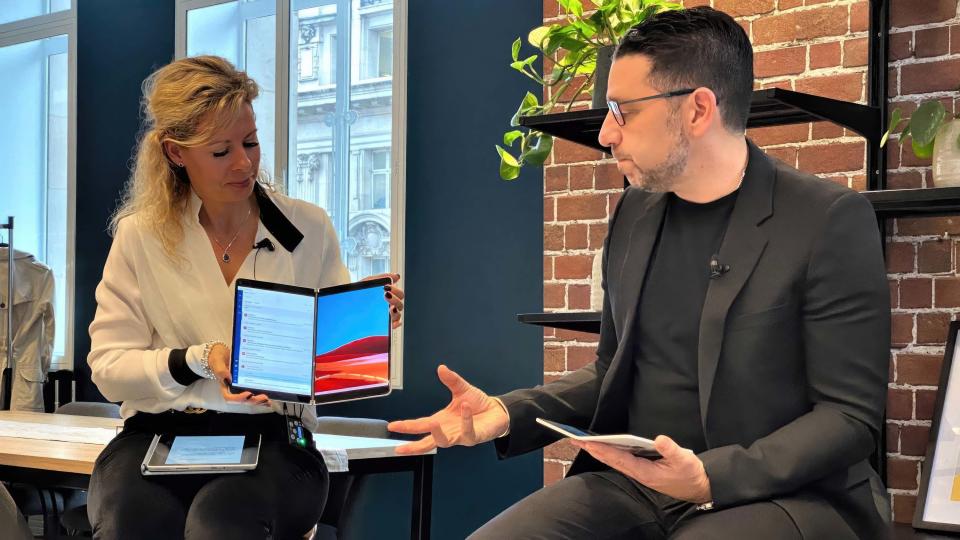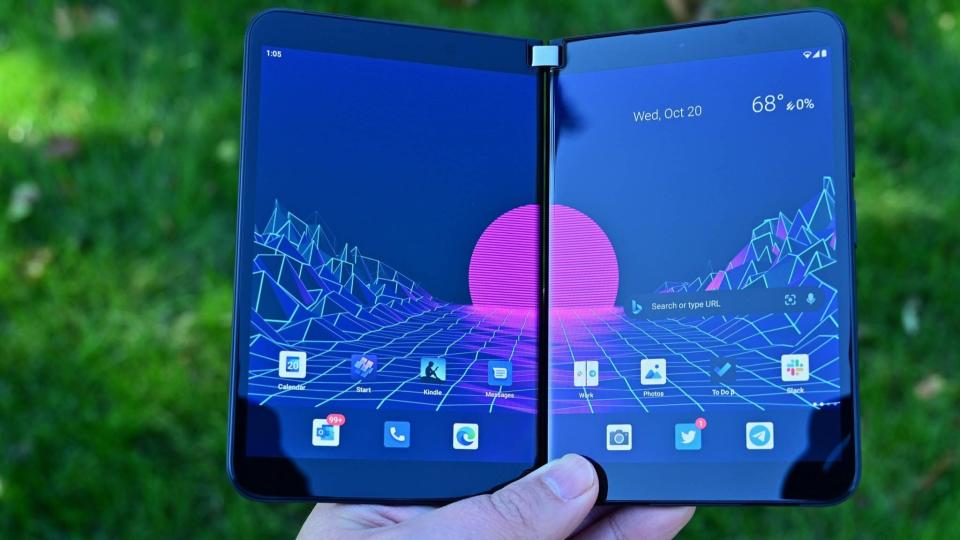4 years ago, Microsoft thought dual-screen devices were the future

On October 2, 2019, Microsoft held what was arguably the best Surface event it's ever put on. It was supposed to be a pinnacle moment for Windows and Surface, with the company willingly pulled back the curtain on products and plans that weren’t yet ready. It was at this event that Microsoft unveiled what it thought was the future of the PC space; dual-screen devices and Windows 10X.
The event started like any other, with a straight to the point unveiling of a new Surface Laptop and Surface Pro. Same design, new specs. Overall good products. Then things went up a notch with the unveiling of the Surface Pro X, which was Microsoft’s first Windows 10 on ARM and an interesting look at where the Surface Pro line was going with regard to design.
But it was the Surface Neo and Surface Duo unveiling that took the world by storm. After then EVP Panos Panay wrapped up his Surface Pro X talk, he paused and said this:
“Now I want to do something we’ve not done before. I want to take a few minutes with you, to talk a little bit about the future of our products.” With hindsight, perhaps Panay wasn’t so sure about talking about the future after all. “I have been debating how to do this, this is not my thing. How do we show you our products before they’re finished? … I was backstage with Satya and I told him I’m more nervous than normal.”
He then went on to state that the product he was about to talk about would be coming next year and compared it to what Surface Pro did for Windows 8 in 2012. “Today we want to introduce you to a new product that I believe is the next category.” Panay claims this device is built to be smaller, personal, yet fully productive.
We then get an incredibly polished look at the Surface Neo, and it looked fantastic. A dual-screen PC running a new version of Windows that’s faster, modern, lightweight, and more secure than any version of Windows before it. It’s unlike any other PC we’ve ever seen, and it’s coming next holiday. I was ecstatic.
There were a few curious statements made during the Surface Neo’s unveiling, including the fact that dual-screens makes you more productive. Panay claimed that Microsoft had “measured brains” to come to this conclusion. While many assumed Microsoft had opted for dual-screen because foldable screens weren’t ready yet, Panay’s talk implies dual-screen was chosen because it’s better for productivity.
After the Surface Neo was unveiled to the world, Panay ended his talk with a “thank you.” But as he began to walk off stage, he paused, turned around, and proclaimed “we’re not done.”
What?
As a member of that audience, I can’t tell you how intense the next few moments were. Nobody knew what was about to be unveiled. We had known for some time that Microsoft was working on a dual-screen phone, but rumors from about a year beforehand proclaimed the project was dead. Turns out, it wasn’t dead, it just switched operating systems… and that’s when Microsoft unveiled the Surface Duo.
I think, based on my tweets from this moment, you can tell I was excited. In fact, I think everyone was excited. It was a bold idea; Microsoft hardware design paired with Google’s Android software. It’s a Microsoft phone without an app gap… ideally, this should be the success story Microsoft has been waiting for, right?
This moment was probably the pinnacle of excitement for me in my career covering technology. I was all-in on Microsoft’s vision for the future of Surface and Windows. I was ready to be that guy with a dual-screen PC in my bag and dual-screen phone in my pocket. Roll on Holiday 2020.
Vaporware and failure

Things didn’t exactly go to plan, unfortunately. We all know it now, but the Surface Neo was a pipe dream; A product that Microsoft wasn’t actually able to build. The hardware was beautiful, but plagued with bad silicon that caused the device to overheat. It was also launching with an operating system that wasn’t ready, and needed at least another couple of years in the oven.
So in May 2020, just seven months after Surface Neo was unveiled to the world, Microsoft announced that the device was postponed and Windows 10X would be delayed. Curiously, Surface Duo was not delayed, and launched ahead of schedule on September 10, 2020.
Surface Duo was our first look at Microsoft’s vision for a productive smartphone. A dual-screen device running Android. On paper, why would this fail? As long as Microsoft nails the software experience, this device should be a hit? Well, unfortunately, Microsoft didn’t nail the software experience, not even close.
The Surface Duo famously launched with what might be the buggiest launch day software ever seen on an Android phone. The device barely worked as intended. I was a day one buyer, and I can admit that the software was rough. Many people returned theirs due to the software alone. Then there was the fact that Surface Duo was missing key smartphone features, like NFC for wireless payments, wireless charging, and a good camera.

These issues were addressed with Surface Duo 2, but the market had already made up its mind about a Microsoft-made dual-screen phone by then. Many reviewers panned the Surface Duo 2 for not being a true foldable, and this caused Microsoft to push on the brakes. I loved my Surface Duo 2, but the market seemingly didn’t want to pay such high prices for a phone that didn’t have a foldable screen.
Microsoft then fumbled supporting the device once it was on the market. Surface Duo launched on Android 10, and received just two major software updates before Microsoft dropped support for it. Surface Duo 2 launched with Android 11, and has only received Android 12L as a major OS update so far. Android 13 has been out for a year, and Android 14 is set to launch imminently.
So far, it looks like Microsoft has no plans to launch Android 13 or Android 14 for Surface Duo 2, which is wild and sets a distressing precedent for future Surface phone hardware. Microsoft’s inability to support Surface Duo with timely Android OS releases tells you everything you need to know about Microsoft’s commitment to Surface Duo.
Looking to the future

Ultimately, the dual-screen vision Microsoft had failed spectacularly. At this point, there are no plans to deliver dual-screen support in the way Windows 10X did on Windows 11, and most OEMs have all but given up on their dual-screen designs. Lenovo is the only one to have shipped a dual-screen laptop in the last couple of years, and they had to do most of the heavy lifting software wise to get that experience to work.
Even with Microsoft’s vision dead, and its lead now on the way to Amazon, it appears the future now leans on true foldable displays. We’re seeing it on phones, and we’re starting to see it in the PC space too. LG, ASUS, Lenovo, and HP have all unveiled foldable PCs with Windows 11, and there are more on the way. Now, all we need is for Microsoft to support them natively with Windows, and perhaps launch a foldable Surface PC of its own.


